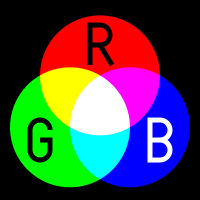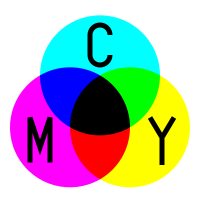Color space

A color space is a specific organization of
A "
Since "color space" identifies a particular combination of the color model and the mapping function, the word is often used informally to identify a color model. However, even though identifying a color space automatically identifies the associated color model, this usage is incorrect in a strict sense. For example, although several specific color spaces are based on the
History
The color-space concept was likely due to Hermann Grassmann, who developed it in two stages. First, he developed the idea of vector space, which allowed the algebraic representation of geometric concepts in n-dimensional space.[3] Fearnley-Sander (1979) describes Grassmann's foundation of linear algebra as follows:[3]
The definition of a linear space (vector space)... became widely known around 1920, when Hermann Weyl and others published formal definitions. In fact, such a definition had been given thirty years previously by Peano, who was thoroughly acquainted with Grassmann's mathematical work. Grassmann did not put down a formal definition—the language was not available—but there is no doubt that he had the concept.
With this conceptual background, in 1853, Grassmann published a theory of how colors mix; it and its three color laws are still taught, as Grassmann's law.[4]
As noted first by Grassmann... the light set has the structure of a cone in the infinite-dimensional linear space. As a result, a quotient set (with respect to metamerism) of the light cone inherits the conical structure, which allows color to be represented as a convex cone in the 3- D linear space, which is referred to as the color cone.[5]
Examples
Colors can be created in
Colors can be created on
Another way of creating colors on a monitor is with an
Many color spaces can be represented as three-dimensional values in this manner, but some have more, or fewer dimensions, and some, such as Pantone, cannot be represented in this way at all.
Conversion
Color space conversion is the translation of the representation of a color from one basis to another. This typically occurs in the context of converting an image that is represented in one color space to another color space, the goal being to make the translated image look as similar as possible to the original.
RGB density
The RGB color model is implemented in different ways, depending on the capabilities of the system used. The most common incarnation in general use as of 2021[update] is the 24-bit implementation, with 8 bits, or 256 discrete levels of color per channel.[6] Any color space based on such a 24-bit RGB model is thus limited to a range of 256×256×256 ≈ 16.7 million colors. Some implementations use 16 bits per component for 48 bits total, resulting in the same gamut with a larger number of distinct colors. This is especially important when working with wide-gamut color spaces (where most of the more common colors are located relatively close together), or when a large number of digital filtering algorithms are used consecutively. The same principle applies for any color space based on the same color model, but implemented at different bit depths.
Lists
Generic


xvYCC is a new international digital video color space standard published by the IEC (IEC 61966-2-4). It is based on the ITU BT.601 and BT.709 standards but extends the gamut beyond the R/G/B primaries specified in those standards.
HSV (hue, saturation, value), also known as HSB (hue, saturation, brightness) is often used by artists because it is often more natural to think about a color in terms of hue and saturation than in terms of additive or subtractive color components. HSV is a transformation of an RGB color space, and its components and colorimetry are relative to the RGB color space from which it was derived.
HSL (hue, saturation, lightness/luminance), also known as HLS or HSI (hue, saturation, intensity) is quite similar to HSV, with "lightness" replacing "brightness". The difference is that the brightness of a pure color is equal to the brightness of white, while the lightness of a pure color is equal to the lightness of a medium gray.
Commercial
Special-purpose
- The RG Chromaticity space is used in computer visionapplications. It shows the color of light (red, yellow, green etc.), but not its intensity (dark, bright).
- The TSL color space (Tint, Saturation and Luminance) is used in face detection.
Obsolete
Early color spaces had two components. They largely ignored blue light because the added complexity of a 3-component process provided only a marginal increase in fidelity when compared to the jump from monochrome to 2-component color.
- RG for early Technicolorfilm
- RGK for early color printing
Absolute color space
In color science, there are two meanings of the term absolute color space:
- A color space in which the perceptual difference between colors is directly related to
- A color space in which colors are unambiguous, that is, where the interpretations of colors in the space are colorimetrically defined without reference to external factors.[13][14]
In this article, we concentrate on the second definition.
A non-absolute color space can be made absolute by defining its relationship to absolute colorimetric quantities. For instance, if the red, green, and blue colors in a monitor are measured exactly, together with other properties of the monitor, then RGB values on that monitor can be considered as absolute. The CIE 1976 L*, a*, b* color space is sometimes referred to as absolute, though it also needs a white point specification to make it so.[15]
A popular way to make a color space like RGB into an absolute color is to define an ICC profile, which contains the attributes of the RGB. This is not the only way to express an absolute color, but it is the standard in many industries. RGB colors defined by widely accepted profiles include sRGB and Adobe RGB. The process of adding an ICC profile to a graphic or document is sometimes called tagging or embedding; tagging, therefore, marks the absolute meaning of colors in that graphic or document.
Conversion errors
A color in one absolute color space can be converted into another absolute color space, and back again, in general; however, some color spaces may have gamut limitations, and converting colors that lie outside that gamut will not produce correct results. There are also likely to be rounding errors, especially if the popular range of only 256 distinct values per component (8-bit color) is used.
One part of the definition of an absolute color space is the viewing conditions. The same color, viewed under different natural or artificial lighting conditions, will look different. Those involved professionally with color matching may use viewing rooms, lit by standardized lighting.
Occasionally, there are precise rules for converting between non-absolute color spaces. For example, HSL and HSV spaces are defined as mappings of RGB. Both are non-absolute, but the conversion between them should maintain the same color. However, in general, converting between two non-absolute color spaces (for example, RGB to CMYK) or between absolute and non-absolute color spaces (for example, RGB to L*a*b*) is almost a meaningless concept.
Arbitrary spaces
A different method of defining absolute color spaces is familiar to many consumers as the swatch card, used to select paint, fabrics, and the like. This is a way of agreeing a color between two parties. A more standardized method of defining absolute colors is the Pantone Matching System, a proprietary system that includes swatch cards and recipes that commercial printers can use to make inks that are a particular color.
See also
- Color model – Mathematical model describing colors as tuples of numbers
- List of color spaces and their uses
- Color theory – Principles to describe the practical behavior of colors
- Lists of colors
- Primary color – Sets of colors that can be mixed to produce gamut of colors
References
- S2CID 33425148. Retrieved 28 November 2023.
- .
- ^ a b Hermann Grassmann and the Creation of Linear Algebra
- .
- PMID 25589300.
- ^ Kyrnin, Mark (2021-08-26). "Why You Need to Know What Color Bit Depth Your Display Supports". Lifewire. Retrieved 2022-07-04.
- ^ William David Wright, 50 years of the 1931 CIE Standard Observer. Die Farbe, 29:4/6 (1981).
- ^ Charles Poynton, "YUV and 'luminance' considered harmful: a plea for precise terminology in video", online, author-edited version of Appendix A of Charles Poynton, Digital Video and HDTV: Algorithms and Interfaces, Morgan–Kaufmann, 2003. online
- ^ Charles Poynton, Constant Luminance, 2004
- ^ Dean Anderson. "Color Spaces in Frame Grabbers: RGB vs. YUV". Archived from the original on 2008-07-26. Retrieved 2008-04-08.
- ISBN 3-527-30436-3.
- ISBN 3-527-30363-4.
- ISBN 1-56592-484-3.
absolute color space.
- ISBN 978-0-8194-6605-1.
- ISBN 0-8194-6020-6.
External links
- Color FAQ, Charles Poynton
- Color Science, Dan Bruton
- Color Spaces, Rolf G. Kuehni (October 2003)
- Colour spaces – perceptual, historical and applicational background, Marko Tkalčič (2003)
- Color formats for image and video processing – Color conversion between RGB, YUV, YCbCr and YPbPr.
- C library of SSE-optimised color format conversions.
- Konica Minolta Sensing: Precise Color Communication

